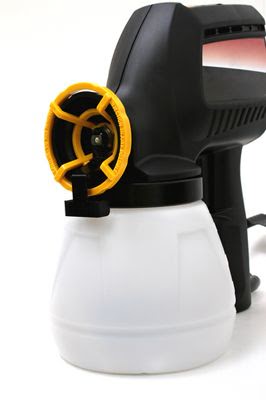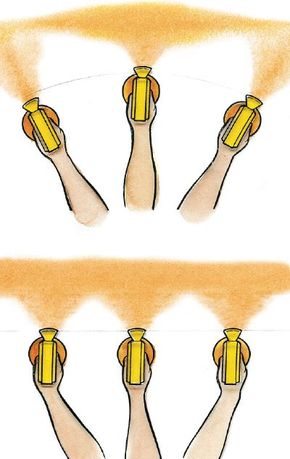Home Improvement

Fix-It Club
When it comes to larger painting projects, using an airless sprayer is the most efficient way to apply paint. This type of sprayer uses an electric hydraulic pump to transfer paint from a container, through a tube, and into a high-pressure hose that’s connected to a spray gun. Once you’ve got the hang of it, using an airless sprayer is relatively simple, but if you’re renting one, be sure to obtain a set of written instructions.
The instructions should provide guidance on how to flush the system with solvent, which is usually water or mineral spirits depending on the type of paint you’ll be using, and how to pump the paint through the hose to the spray gun. For clean-up, the process is reversed by pumping out any leftover paint and flushing the system with solvent.
You’ll only need the sprayer for a day or two, but allow at least one extra day to thoroughly mask off anything you don’t want to paint. Tape down drop cloths on all floor surfaces, drape windows, the fireplace, and doors, remove all hardware, or cover it with masking tape. Mask switches and outlets as well. When using a sprayer, paint travels on air currents and settles as a fine mist of overspray on almost every surface in a room.
Make sure to keep at least one window open in each room and set up an exhaust fan to draw paint vapor out of the room. Wear a painters’ mask, a hat, and old clothes with long sleeves to protect your arms.
Airless sprayers are equipped with multiple filters to prevent paint particles and foreign matter from clogging the spray tip, but it’s still a good idea to filter the paint yourself through a nylon stocking or paint filter before pumping it through the hose.
Tips for Effective Airless Sprayer Use

Using an airless sprayer effectively requires some practice, so start by using scrap plywood or an inconspicuous part of the room or house. The goal is to cover the surface with a uniform coating of paint. Hold the spray gun at a constant distance of 6 to 12 inches from the surface and maintain this distance with each pass of the gun. Keep the gun parallel to the wall at all times. Avoid sweeping it back and forth, as this will result in a wide arc of paint on the wall, with the paint concentrated in the middle and almost transparent at each end.
Paint about a 3-foot horizontal strip at a time, then release the trigger and drop down to paint another strip of the same length, overlapping the first strip by one-third to one-half. Once you’ve covered a 3-foot-wide area from the top of the wall to the bottom, go back to the top and start another 3-foot section adjacent to the first, overlapping the edge of the first painted area by several inches as you work your way down the wall.
To ensure a consistent coat of paint, check that the entire surface is covered evenly. If there is too much paint, it will drip or run, and if there is too little, the old paint will show through. If you notice these issues, it may be because the spray gun is not at a uniform distance from the wall or is tilted. Tilting the gun upwards will result in excess paint at the bottom of the strip, while tilting it downwards will concentrate the paint at the top.
To prevent paint buildup at the end of each strip, release the trigger on the spray gun a fraction of a second before it stops moving. When starting a new strip, begin moving the gun a fraction of a second before compressing the trigger. Keep the gun moving at all times when spraying.
Additionally, make sure that the paint is properly thinned and that the pressure control is adjusted according to the manufacturer’s instructions. If there is too much or too little thinner or the pressure is too high or too low, the paint will not atomize correctly.
When using an airless sprayer, be sure to follow the manufacturer’s instructions carefully as they can be dangerous due to the high pressure they supply. Keep the safety lock on when not painting, ensure the spray gun has a trigger guard and safety shield around its tip, and never point it at another person. Clean the gun and filters after turning off and disconnecting the sprayer from its electrical source. Work in a well-ventilated area, wear a mask, and do not smoke or have open flames nearby. Keep the sprayer out of reach of children and pets.
For more information, see related articles on house painting, house painting tools, painting interiors, and painting safety.
FAQ
1. What is an airless sprayer and how does it work?
An airless sprayer is a tool used for painting, staining, and finishing. Unlike traditional sprayers, airless sprayers use a pump to pressurize the paint, forcing it through a small tip that atomizes the paint into a fine mist. This mist is then sprayed onto the surface being painted. Airless sprayers are popular because they are fast and efficient, allowing you to cover a large area quickly and evenly.
2. What types of projects are best suited for an airless sprayer?
Airless sprayers are ideal for large projects, such as painting a house or staining a deck. They are also great for projects that require a smooth finish, such as cabinets or furniture. Because they apply paint quickly and evenly, they can save you time and produce a more professional-looking finish than traditional brushes and rollers.
3. What safety precautions should I take when using an airless sprayer?
When using an airless sprayer, it is important to wear protective gear, such as safety goggles, a respirator mask, and gloves. Make sure the area you are working in is well-ventilated, as the fumes from the paint can be harmful. Always follow the manufacturer’s instructions for setup and use, and never point the sprayer at anyone.
4. How do I prepare the surface for painting with an airless sprayer?
Before using an airless sprayer, it is important to properly prep the surface you will be painting. This includes cleaning the surface to remove dust and debris, repairing any cracks or holes, and sanding the surface to create a smooth finish. You should also tape off any areas that you do not want to be painted.
5. What type of paint should I use with an airless sprayer?
Airless sprayers can be used with a variety of paints, including latex and oil-based paints, stains, and varnishes. However, it is important to choose a paint that is compatible with your specific sprayer. Read the manufacturer’s instructions for information on which types of paint are recommended for your sprayer.
6. How do I clean and maintain my airless sprayer?
After each use, it is important to clean your airless sprayer thoroughly to prevent buildup and damage to the pump and tip. Follow the manufacturer’s instructions for cleaning, which may include flushing the sprayer with water or a cleaning solution. You should also inspect the sprayer regularly for any signs of wear or damage, and replace any parts as needed.

Brody is a skilled craftsman and gardening expert. From renovating living spaces to cultivating lush gardens, Brody’s knowledge and passion shine through, inspiring readers to embark on their own home improvement and gardening journeys with confidence.






Leave a Reply